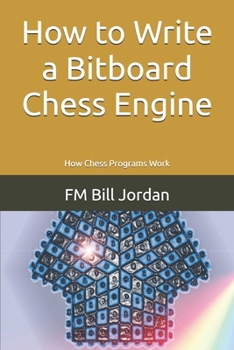How to Write a Bitboard Chess Engine: How Chess Programs Work
Learn how to build your own fast, modern chess engine using bitboards and clear, easy-to-follow C++ code.
How to Write a Bitboard Chess EngineThere are many reasons why you might be interested in learning how a chess program is written:
You're learning programming and want to try something different.You're a programmer looking to expand your skills and explore a fascinating project.You're a chess enthusiast who wants to understand how chess engines think and evaluate.You'd like to create your own chess program to play against.You're interested in developing an engine to compete in chess tournaments.You don't need to be an expert programmer to understand this book. The code is written as clearly and simply as possible-designed to be accessible even for intermediate or novice programmers.
If you're not a programmer but love chess, this book will still fascinate you. It offers an inside look at how computers analyse positions and choose moves, deepening your appreciation of the game.
The book includes a fully annotated version of the source code for a complete chess engine. The code is available on GitHub and can be compiled with a freely downloadable compiler. You can study the source, modify it, and see if you can make it stronger. Alternatively, you can simply download the exe file and play against it-the engine is strong enough to beat most social players.
Why Bitboards?Bitboards make a chess engine faster, simpler, and often shorter. Many calculations that normally require loops can be performed in a single statement. Bitboards can be used for move generation, evaluation, and position updating, all with remarkable efficiency.
Topics Covered Include: How bitboards store piece positions.Move and capture generation.Detecting blocked lines, passed pawns, and isolated pawns.Managing castling permissions and pawn hash tables.Using bitwise operations: AND, OR, XOR, NOT, left shift, and right shift.Engine Features: Can load and play from any position.Compatible with popular chess GUIs such as Arena.Extremely fast search speed.Displays the best line of play for both sides.Detects checkmate, stalemate, 50-move rule, and draw by repetition.Evaluation and Search:The engine evaluates multiple elements of a position, including:
Material balance.Piece placement and mobility.King safety.Pawn structure and passed pawns.Its alpha-beta minimax search incorporates:
Move ordering and cut-offs.History heuristics and hash tables.Extensions and reductions.Capture and quiescence searches.And much more...
Related Titles by the Same Author: The Joy of Chess ProgrammingThink Like a ComputerHow to Write a Chess ProgramHow to Write a JavaScript Chess EngineAdvanced Chess ProgrammingHow to Write a Complex Chess EngineHow to Write a Simple Chess Neural NetworkThe author is a FIDE Chess Master and national senior chess champion, as well as an experienced IT trainer who taught programming languages such as C++ for over a decade. His passion for both chess and programming shines through every page.





